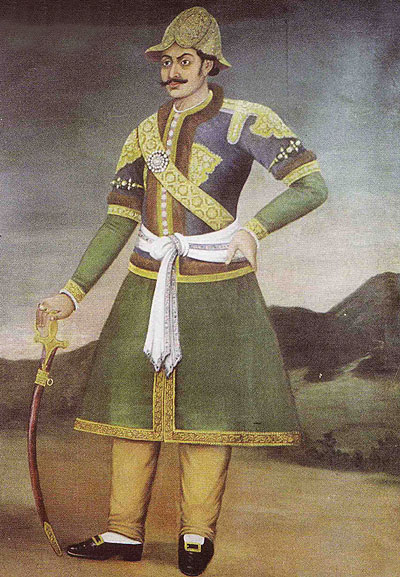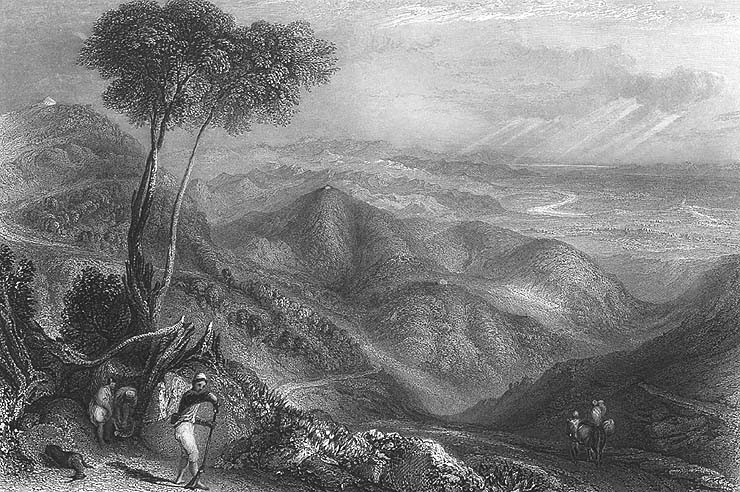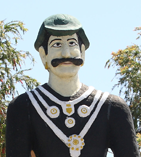|
Gurkha War
The Anglo-Nepalese War (1 November 1814 – 4 March 1816), also known as the Gorkha War, was fought between the Gorkhali army of the Kingdom of Nepal (present-day Nepal) and the British forces of the East India Company (EIC, present-day India). Both sides had ambitious expansion plans for the mountainous north of the Indian subcontinent. The war ended with the signing of the Treaty of Sugauli in 1816 AD, which ceded some Nepalese controlled territory to the EIC. The British war effort was led by the East India Company and supported by a coalition of native states; the Garhwal Kingdom, the Patiala State and the Kingdom of Sikkim against the Kingdom of Gorkha. The Kingdom of Gorkha's war effort was led mostly by the two Thapa families; Thapa dynasty and Family of Amar Singh Thapa. Historical background The Shah era of Nepal began with the Gorkha king Prithvi Narayan Shah invading Kathmandu valley, which consisted of the capital of the Malla confederacy. Until that time o ... [...More Info...] [...Related Items...] OR: [Wikipedia] [Google] [Baidu] |
Bhakti Thapa
Bhakti Thapa Chhetri ( ne, भक्ति थापा क्षेत्री; 1741 A.D. Lamjung, Nepal – 1815 A.D.) was a Nepalese military commander and administrator in the Kingdom of Nepal. Initially, he served for the Kingdom of Lamjung. He is considered one of the national heroes of Nepal. ''Grand Old Man'' Bhakti Thapa Chhetri was the Sardar (commander) of Lamjung state, so he fought against Gorkhali in the battle from the side of Kehari Narayan, the King of Lamjung. After the fall of Lamjung in the battle against the Gorkhali (Nepali) forces, he was captured and brought to Kathmandu as a prisoner of war. Later he was appointed as sirdar (one of the sirdars) in the Nepali army. Just two years after the unification of Jumla, he was made the supreme commander (Sardar) of the Nepalese army stationed to the west of the capital in a region that stretched almost up to the Sutlej river, and also the administrator of this region. Sardar Bhakti Thapa's great success i ... [...More Info...] [...Related Items...] OR: [Wikipedia] [Google] [Baidu] |
Dalbhanjan Pande
Dalbhanjan Pande or Dalabhanjan Pande ( ne, दलभञ्जन पाँडे) was a Nepalese minister, politician and military officer of the aristocratic Pande family. He had held ministerial positions and military offices. He jointly headed the military administration of Nepal in 1837 along with '' Mukhtiyar'' Rana Jang Pande. Life as politician and military officer Dalbhanjan followed the King Rana Bahadur Shah into exile to Banaras along with Bhimsen Thapa and the Senior Queen Raj Rajeshwari Devi. In July 1804, he along with Badakaji Amar Singh Thapa informed the Company's in-charge ''Daroga'' about the orders of takeover of Butwal plains and honor Palpa's former obligations from the King of Gorkha. After 1806, the territories of Palpa were kept under the military governorship of him and Bada Amar Singh Thapa. In 1806, he was deputed to Kangra Fort along with Rudra Vir Shah as senior military officers after the death of Kaji Nain Singh Thapa in the conquest. He w ... [...More Info...] [...Related Items...] OR: [Wikipedia] [Google] [Baidu] |
Battle Of Nalapani
The Battle of Nalapani was the first battle of the Anglo-Nepalese War of 1814–1816, fought between the forces of the British East India Company and Nepal, then ruled by the House of Gorkha. The battle took place around the Nalapani fort, near Dehradun, which was placed under siege by the British between 31 October and 30 November 1814. The fort's garrison was commanded by Captain Balbhadra Kunwar, while Major-General Robert Rollo Gillespie, who had previously fought in the Battle of Java, was in charge of the attacking British troops. Gillespie was killed on the first day of the siege while rallying his men. Despite considerable odds, both in terms of numbers and firepower, Balbhadra and his 600-strong garrison successfully held out against more than 5,000 British troops for over a month. After two costly and unsuccessful attempts to seize the fort by direct attack, the British changed their approach and sought to force the garrison to surrender by cutting off the fort's exte ... [...More Info...] [...Related Items...] OR: [Wikipedia] [Google] [Baidu] |
Dehradun
Dehradun () is the capital and the most populous city of the Indian state of Uttarakhand. It is the administrative headquarters of the eponymous district and is governed by the Dehradun Municipal Corporation, with the Uttarakhand Legislative Assembly holding its winter sessions in the city as its winter capital. Part of the Garhwal region, and housing the headquarters of its Divisional Commissioner. Dehradun is one of the " Counter Magnets" of the National Capital Region (NCR) being developed as an alternative center of growth to help ease the migration and population explosion in the Delhi metropolitan area and to establish a smart city in the Himalayas. It is the third largest city in the Himalayas after Kathmandu and Srinagar. Dehradun is located in the Doon Valley on the foothills of the Himalayas nestled between Song river, a tributary of Ganga on the east and the Asan river, a tributary of Yamuna on the west. The city is noted for its picturesque landscape and sl ... [...More Info...] [...Related Items...] OR: [Wikipedia] [Google] [Baidu] |
Ranjore Thapa
Ranajor Singh Thapa anglicised as Ranjore Thapa ( ne, रणजोर सिंह थापा) was governor of Kumaun and Garhwal and commander of Jaithak Fort during Anglo-Nepalese war at Battle of Jaithak. He was born to General Bada Kaji Amar Singh Thapa. His brother Ranadhoj Thapa served as deputy to Prime Minister Bhimsen Thapa. Ranajor Singh set up position at Jaithak overlooking Nahan. On the night of 25 December, British and Indian native sepoys climbed to get into better position to attack at Ranajor Singh's forces. Major Ludlow, who led the attack up the southern slope of the ridge, left the camp at midnight and came first upon the enemy. But the Nepalese thwarted British down the mountain side. Ludlow fell in with Ranajor Singh's outer picquet at three in the morning, at about a mile's distance from the point to be occupied. Major General Martindell ordered retreat and first war ended. When General Ochterlony came up with heavy forces and modern equipments, Nepa ... [...More Info...] [...Related Items...] OR: [Wikipedia] [Google] [Baidu] |
Ranbir Singh Thapa
Ranabir Singh Thapa ( ne, रणवीर सिंह थापा) also spelled Ranbir, Ranavir or Ranvir also known by the late ascetic name Swami Abhayananda ( ne, स्वामी अभयानन्द) was a Nepalese Army General, prominent politician and minister of state. In 1837, he became Acting Mukhtiyar (equivalent to Prime Minister) of Nepal for a brief period. He was a prominent member of Thapa dynasty. He later turned ascetic and was known by the Sanyasi name Swami Abhayananda. Early life Ranabir Singh was born as the youngest son of ''Sanukaji'' Amar Singh Thapa and Satyarupa Maya. He was the brother of Mukhtiyar Bhimsen Thapa. Life as politician and military officer He was the Commander of the Makwanpur-Hariharpur axis during Anglo-Nepalese war. In 1871 BS (1814 AD) he was deputed to Makwanpur to command the troops. He was leading 4000 soldiers against Major General Marley and Major General Woods. They were lured to major killing area by Ranabir Singh ... [...More Info...] [...Related Items...] OR: [Wikipedia] [Google] [Baidu] |
Family Of Amar Singh Thapa
The family of ''Badakaji'' Amar Singh Thapa (1751 - 1816) was a noble Chhetri family in the central politics of Kingdom of Nepal as well as former military aristocracy of Gorkha Kingdom. The family of Bhimsen Thapa and the family of Amar Singh Thapa were two Bagale Thapa families and part of larger Thapa caucus at the central politics of the Kingdom of Nepal. The patriarch of this family is Ranjai Thapa of Siranchowk whose son ''Bagh'' Bhim Singh Thapa became a military commander of Gorkha Kingdom and died in the battle of Palanchowk. Bhim Singh's son and the most prominent member of this family, Amar Singh Thapa went on to become overall commander (in capacity of Mukhtiyar) of Kumaon, Garhwal and its West region in the Kingdom of Nepal. Amar Singh's sons and grandsons were influential Bharadars (state-bearing officers), politicians, ministers and military commanders in the Kingdom of Nepal. The family was also maritally connected with Kunwar family of Gorkha. Amar Singh Thapa w ... [...More Info...] [...Related Items...] OR: [Wikipedia] [Google] [Baidu] |
Thapa Dynasty
Thapa dynasty or Thapa noble family ( ne, थापा वंश/थापा काजी खलक ) was a Kshatriya political family that handled Nepali administration affairs between 1806 and 1837 A.D. and 1843 to 1845 A.D. as Mukhtiyar (Prime Minister). This was one of the four noble families to be involved in the active politics of the Kingdom of Nepal, along with the Shah dynasty, Basnyat family, and the Pande dynasty before the rise of the Rana dynastyor Kunwar family. At the end of 18th century, Thapas had extreme dominance over Nepalese Darbar politics alternatively contesting for central power against the Pande family. Bir Bhadra Thapa was a Thapa of Chhetri group and leading Bharadar during Unification of Nepal. His grandson Bhimsen Thapa became Mukhtiyar of Nepal and established Thapa dynasty to the dominating position of central court politics of Nepal. The Thapa family gave rise to the Rana dynasty of Jung Bahadur Kunwar Rana whose father B ... [...More Info...] [...Related Items...] OR: [Wikipedia] [Google] [Baidu] |
Anno Domini
The terms (AD) and before Christ (BC) are used to label or number years in the Julian and Gregorian calendars. The term is Medieval Latin and means 'in the year of the Lord', but is often presented using "our Lord" instead of "the Lord", taken from the full original phrase "''anno Domini nostri Jesu Christi''", which translates to 'in the year of our Lord Jesus Christ'. The form "BC" is specific to English and equivalent abbreviations are used in other languages: the Latin form is but is rarely seen. This calendar era is based on the traditionally reckoned year of the conception or birth of Jesus, ''AD'' counting years from the start of this epoch and ''BC'' denoting years before the start of the era. There is no year zero in this scheme; thus ''the year AD 1 immediately follows the year 1 BC''. This dating system was devised in 525 by Dionysius Exiguus, but was not widely used until the 9th century. Traditionally, English follows Latin usage by placing the ... [...More Info...] [...Related Items...] OR: [Wikipedia] [Google] [Baidu] |
Nepal
Nepal (; ne, नेपाल ), formerly the Federal Democratic Republic of Nepal ( ne, सङ्घीय लोकतान्त्रिक गणतन्त्र नेपाल ), is a landlocked country in South Asia. It is mainly situated in the Himalayas, but also includes parts of the Indo-Gangetic Plain, bordering the Tibet Autonomous Region of China to the north, and India in the south, east, and west, while it is narrowly separated from Bangladesh by the Siliguri Corridor, and from Bhutan by the Indian state of Sikkim. Nepal has a diverse geography, including fertile plains, subalpine forested hills, and eight of the world's ten tallest mountains, including Mount Everest, the highest point on Earth. Nepal is a multi-ethnic, multi-lingual, multi-religious and multi-cultural state, with Nepali as the official language. Kathmandu is the nation's capital and the largest city. The name "Nepal" is first recorded in texts from the Vedic period of the ... [...More Info...] [...Related Items...] OR: [Wikipedia] [Google] [Baidu] |
Gorkhali Army
The Nepali Army ( ne, नेपाली सेना, translit=Nēpālī Sēnā), technically the Gorkhali Army ( ne, गोरखाली सेना, translit=Gōrakhālī Sēnā, label=none; see ''Gorkhas''), is the land service branch of the Nepali Armed Forces. During the period of the Nepali unification campaign, it was known as the ''Gorkhali Army'' and later as the ''Royal Nepali Army'' following the establishment of a Hindu monarchy in Nepal. It was officially renamed to the Nepali Army on 28 May 2008, following the abolition of the 240-year-old Shah dynasty shortly after the Nepali Civil War. The Nepali Army has participated in various conflicts throughout its history, going as far back as the Nepali unification campaign launched by Prithvi Narayan Shah of the Gorkha Kingdom. It has engaged in an extensive number of battles within South Asia, and continues to take part in global conflicts as part of United Nations peacekeeping coalitions. The Nepali Army is ... [...More Info...] [...Related Items...] OR: [Wikipedia] [Google] [Baidu] |
Bakhtawar Singh Thapa
Bakhtawar Singh Thapa ( ne, बख्तावर सिंह थापा) also spelled Bhaktawar, was a Nepalese military commander, politician, and governor. He acted as an aide of his brother ''Mukhtiyar'' Bhimsen Thapa and was appointed the commander of Samar Jung Company. He commanded the Bijayapur-Sindhuli Gadhi Axis in the first campaign of Anglo-Nepalese War and Makwanpur Gadhi Axis in the second campaign. Later, he became the governor of Palpa and died in the office. Early life Bakhtawar Singh Thapa was born to military officer ''Kaji'' Amar Singh Thapa (sanu) and Satyarupa Maya. He was the brother of Mukhtiyar Bhimsen Thapa and had other three brothers - Nain Singh Thapa, Amrit Singh Thapa, and Ranabir Singh Thapa. From his step-mother, he had two brothers—Ranbam and Ranzawar. His ancestors were members of Bagale Thapa clan from Jumla who migrated eastwards. His grandfather was Bir Bhadra Thapa, a courtier in Prithvi Narayan Shah's army. Career Commander of the ... [...More Info...] [...Related Items...] OR: [Wikipedia] [Google] [Baidu] |





.jpg)
